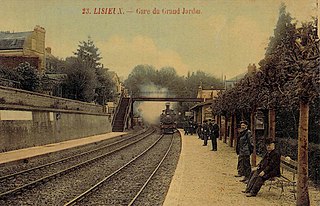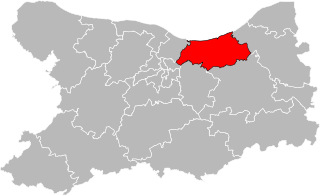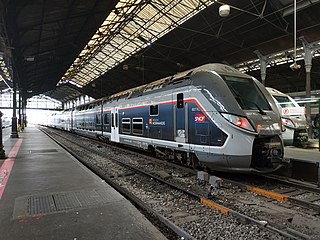
The Independent Belgian Brigade was a Belgian and Luxembourgish military unit in the Free Belgian forces during World War II, commonly known as the Piron Brigade after its commanding officer Jean-Baptiste Piron. It saw action in Western Europe and participated in the Battle of Normandy, the Liberation of Belgium, and fighting in the Netherlands over 1944-1945.

Houlgate is a small tourist resort in northwestern France along the English Channel with a beach and a casino. It is a commune in the Calvados department in the Normandy region.

The Pays d'Auge is an area in Normandy, straddling the départements of Calvados and Orne. The chief town is Lisieux.

The arrondissement of Lisieux is an arrondissement of France in the Calvados department in the Normandy region. It has 160 communes. Its population is 159,921 (2021), and its area is 1,756.2 km2 (678.1 sq mi).
The Compagnie des chemins de fer de l'Ouest, often referred to simply as L'Ouest or Ouest, was an early French railway company which operated from the years 1855 through 1909.
Autoroute 132 links the A13 and Deauville & Trouville-sur-Mer. It starts between exits 28 and 29a on the A13 and ends in the outskirts of Touques, just south of the village of Canapville on the N177.

is the main train station for the town of Lisieux, Normandy, France.

Gare du Grand-Jardin is the second station of Lisieux, Normandy. The station is only used by local services on the line from Lisieux to Trouville-Deauville. Le Grand-Jardin station is a public transportation hub known for its convenient location and efficient services.

Trouville-Deauville is the station for the towns of Deauville and Trouville-sur-Mer, Normandy. The station is built in neo-normand architecture and is a terminus for two railway lines, the main line from Paris by Lisieux and the Côte Fleurie branchline to Dives-Cabourg.

Dives-Cabourg is the railway station for the towns of Dives-sur-Mer and Cabourg. The station is built in Ouest architecture and is a terminus for the Côte Fleurie branchline to Trouville-Deauville. The trains between Trouville-Deauville and Dives-Cabourg only run in summer.

Villers-sur-Mer is the railway station for the town of Villers-sur-Mer. The station is built in Ouest architecture and is on the Côte Fleurie branchline from Trouville-Deauville and to Dives-Cabourg.

Hippodrome Deauville-La Touques is a race track for thoroughbred horse racing located in Deauville in the Calvados département, in the Normandy région of France. Originally called Hippodrome de la Touques, it was named for the Touques River that separates the city of Deauville from Trouville-sur-Mer. It was constructed in 1862 by Charles Auguste Louis Joseph, duc de Morny, the half brother of Napoleon III.

The Gare de Bernay is the train station for the town of Bernay, Eure. It was built by Chemins de Fer de l'Ouest in 1855. It is situated on the Mantes-la-Jolie–Cherbourg railway. The station was, like most stations on the line to Cherbourg, built by the line's first concessionary, the Compagnie du chemin de fer de Cherbourg. The station is a traditional building, with the lower part built in granite with red brick walls, with stone doors and window entourages.

The Côte Fleurie stretches for approximately 40 km (25 mi) between Merville-Franceville-Plage, at the mouth of the Orne river, opposite Ouistreham to the west and Honfleur on the Seine estuary in the east. It forms part of the eastern Basse-Normandie coast on the English Channel to the north of the Pays d'Auge in the Calvados department. The coast between the towns of Trouville and Honfleur, although part of the Côte Fleurie, is named Côte de Grace. Dives-sur-Mer is on the Côte Fleurie but possesses no beach or seafront. The Côte de Nacre continues west from the Touques estuary.

The Ligne de la Côte Fleurie is a railway line serving the towns of the Côte Fleurie, Calvados, France.
The Lycée André Maurois is a secondary school in Deauville, France.

The Baie de Seine is a bay in northern France.

The canton of Cabourg is an administrative division of the Calvados department, northwestern France. Its borders were modified at the French canton reorganisation which came into effect in March 2015. Its seat is in Cabourg.

TER Normandie, branded as NomadTrain since 2020, is the regional rail network serving the region of Normandy, northwestern France. It is operated by the French national railway company SNCF. It was formed in 2016 from the previous TER networks TER Basse-Normandie and TER Haute-Normandie, after the respective regions were merged.
















